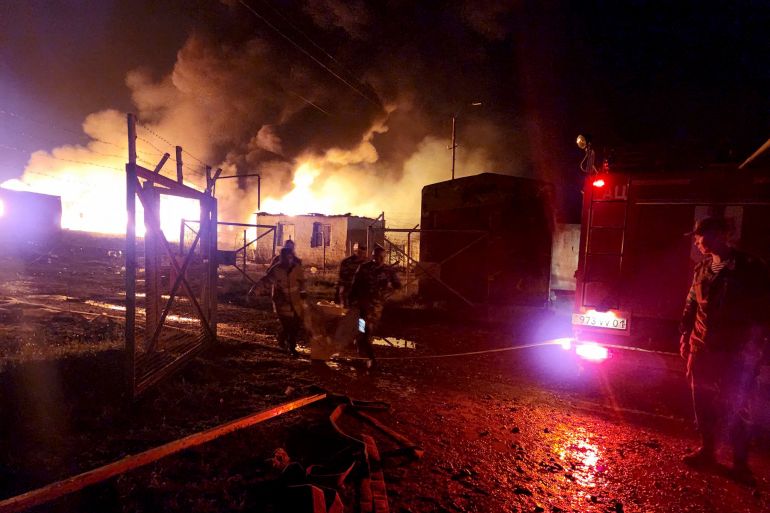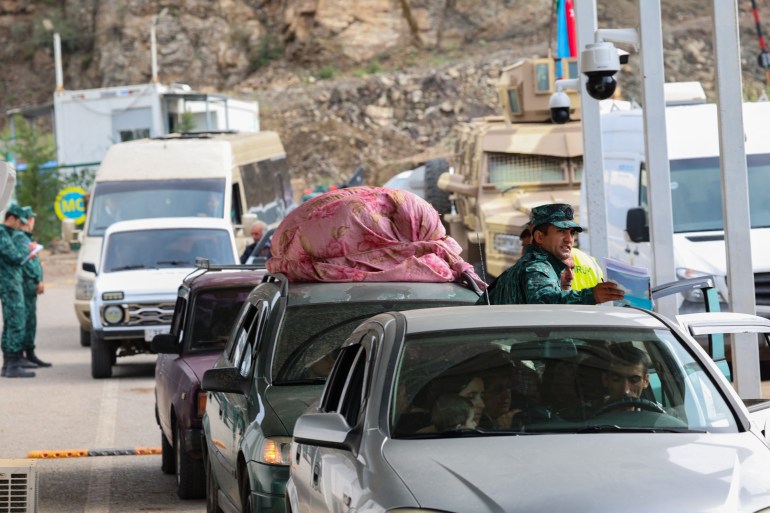Death toll rises in Nagorno-Karabakh fuel depot blast as thousands flee
Armenia says at least 28,120 ethnic Armenians from breakaway region entered the country after Azerbaijan’s offensive.

Dozens of people have been killed and hundreds of others wounded in a fuel depot explosion and fire in Nagorno-Karabakh amid an exodus of ethnic Armenians from the region following a lightning military offensive by Azerbaijan.
The death toll from the blast rose to 68 on Tuesday, the office of Karabakh’s ombudsman said. At least 105 people were missing and 290 others wounded, it said.
Keep reading
list of 3 itemsAzerbaijan and ethnic Armenian forces reach Nagorno-Karabakh ceasefire deal
Will Azerbaijan take full control of Nagorno-Karabakh?
The explosion happened outside the regional capital of Stepanakert – called Khankendi by Azerbaijan – late on Monday. The depot was being used to distribute fuel to those who wanted to leave the region by car. Hundreds of people were gathered there when the explosion took place.
Last week’s offensive came after a months-long blockade of the region by Azerbaijan that caused shortages of essential supplies.
“As a result of the explosion, Azerbaijan prepared nearby local hospitals and started negotiations on the evacuation of the wounded, but representatives of the Armenian residents of Karabakh did not accept this proposal,” said Al Jazeera’s correspondent Osama bin Javaid, reporting from the Azerbaijani city of Horadiz.
The announcement of the death toll came as thousands of people continued to flee the region, with Armenia saying that 28,120 ethnic Armenians had entered the country. The government also said it would provide accommodation for all those in need.
US National Security Council spokeswoman Adrienne Watson said the US urged humanitarian access to the region.
“We are saddened by the news that at least 68 people have been killed and hundreds injured in an explosion at a fuel depot in Nagorno-Karabakh and express deep sympathy to the residents of Nagorno-Karabakh and to all of those suffering,” she said.
“We urge continued humanitarian access to Nagorno-Karabakh for all those in need.”
Samantha Power, head of the US Agency for International Development (USAID), said the US would send $11.5m in humanitarian aid.

Azerbaijan’s military attacked Nagorno-Karabakh on September 19, announcing 24 hours later to have won control over the enclave. The offensive forced ethnic Armenian authorities in the region to agree to lay down weapons and start “reintegration” talks, under a ceasefire agreement brokered by traditional regional powerhouse Russia.
Azerbaijani authorities promised to respect the rights and security of Armenians living in the region. But the news of their reintegration into Azerbaijan met panic and chaos among ethnic Armenians who feared that the long history of hatred and violence between the two would make any form of co-habitation impossible.
On the road heading to Armenia, more and more residents from the region appeared to be trying to get out.
“It’s a steady stream of people, we have seen in the distance miles and miles of queues of people lining up to leave,” said bin Javaid.
“The people are living with whatever they can put their hands, in whatever vehicle they can find, but they want to go out despite all assurances that have been given by the Azerbaijani authorities,” he added.
At a refugee centre in Goris, Valentina Asryan, a 54-year-old from the village of Vank who fled with her grandchildren, told the AFP news agency her brother-in-law was killed and several other people were injured by Azerbaijani fire.
A long dispute
Nagorno-Karabakh has been contested for more than three decades, with Baku and Yerevan vying for its control.
The territory is internationally recognised as part of Azerbaijan, but is heavily populated by ethnic Armenians.
Following the collapse of the Soviet Union, separatists in Nagorno-Karabakh declared their independence with the goal of reuniting with Armenia. That triggered a bloody war in the 1990s that ended with Armenians taking control of the enclave and several districts around it.
Hundreds of thousands of people were displaced due to the conflict.
A second war erupted in 2020 with Azerbaijan retaking territory in and around the enclave.
After 44 days of fighting, Russia brokered a ceasefire and placed nearly 2,000 peacekeepers in Nagorno-Karabakh.